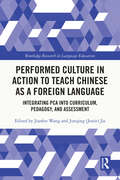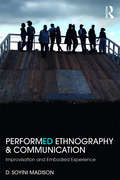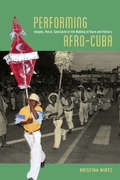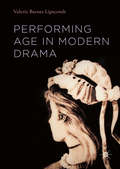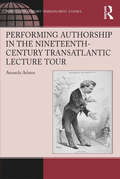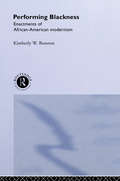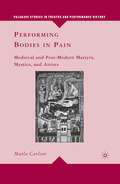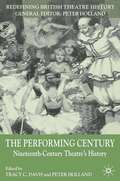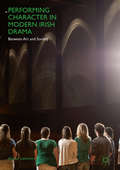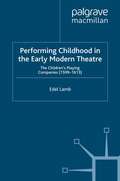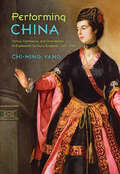- Table View
- List View
Performed Culture in Action to Teach Chinese as a Foreign Language: Integrating PCA into Curriculum, Pedagogy, and Assessment (Routledge Research in Language Education)
by Jianfen Wang Junqing Jessie JiaThis volume explores best practices in implementing the Performed Culture Approach (PCA) in teaching Chinese as a foreign language (CFL).Offering a range of chapters that demonstrate how PCA has been successfully applied to curriculum, instructional design, and assessment in CFL programs and classrooms at various levels, this text shows how PCA’s culture-focused paradigm differs fundamentally from the general communicative language teaching (CLT) framework and highlights how it can inspire innovative methods to better support learners’ ability to navigate target culture and overcome communication barriers. Additional applications of PCA in the development of learner identity, intercultural competence, autonomy, and motivation are also considered.Bridging theoretical innovations and the practice of curriculum design and implementation, this work will be of value to researchers, teacher trainers, and graduate students interested in Chinese teaching and learning, especially those with an interest in incorporating performance into foreign language curriculums with the goal of integrating language and culture.
Performed Ethnography and Communication: Improvisation and Embodied Experience
by D Soyini MadisonPerformed Ethnography and Communication explores the relationships between these three key terms, addressing the impact of ethnography and communication on the cutting edge of performance studies. Ranging from digital performance, improvisation and the body, to fieldwork and staged collaboration, this volume is divided into two main sections: "Embodied technique and practice," which addresses improvisation, devised theatre-making, and body work to consider what makes bodies move, sound, behave, mean, or appear differently, and the effects of these differences on performance; "Oral history and personal narrative performance," which is concerned with the ways personal stories and histories might be transformed into public events, looking at questions of perspective, ownership, and reception. Including specific historical and theoretical case studies, exercises and activities, and practical applications for improvisation, ethnography, and devised and digital performance, Performed Ethnography and Communication represents an invaluable resource for today’s student of performance studies, communication studies or cultural studies.
Performed Ethnography and Communication: Improvisation and Embodied Experience
by D Soyini MadisonPerformed Ethnography and Communication explores the relationships between these three key terms, addressing the impact of ethnography and communication on the cutting edge of performance studies. Ranging from digital performance, improvisation and the body, to fieldwork and staged collaboration, this volume is divided into two main sections: "Embodied technique and practice," which addresses improvisation, devised theatre-making, and body work to consider what makes bodies move, sound, behave, mean, or appear differently, and the effects of these differences on performance; "Oral history and personal narrative performance," which is concerned with the ways personal stories and histories might be transformed into public events, looking at questions of perspective, ownership, and reception. Including specific historical and theoretical case studies, exercises and activities, and practical applications for improvisation, ethnography, and devised and digital performance, Performed Ethnography and Communication represents an invaluable resource for today’s student of performance studies, communication studies or cultural studies.
The Performer in Mass Media: Connecting with Television and Online Audiences
by Beth OlsonThis book is a concise guide written by two individuals who have been there—under the lights and in front of the camera. Its no-nonsense approach offers readers practical advice about on-camera performance, including key aspects of voice, movement, communication and appearance. It gives them a foundation for working in the studio, in the field and in front of an audience; it is ideal for media performers of any type, including those who work as reporters, company spokespersons, or community advocates.Recommendations include how to properly position oneself for a shot, how to improve articulation, how to deal with stress and how to best perform online. "Try-It-Out" exercises help readers put what they have learned into practice and prepare to be on camera. Key terms are bolded in the chapters and are collected in a book-end Glossary for easy reference.
The Performer in Mass Media: Connecting with Television and Online Audiences
by Beth OlsonThis book is a concise guide written by two individuals who have been there—under the lights and in front of the camera. Its no-nonsense approach offers readers practical advice about on-camera performance, including key aspects of voice, movement, communication and appearance. It gives them a foundation for working in the studio, in the field and in front of an audience; it is ideal for media performers of any type, including those who work as reporters, company spokespersons, or community advocates.Recommendations include how to properly position oneself for a shot, how to improve articulation, how to deal with stress and how to best perform online. "Try-It-Out" exercises help readers put what they have learned into practice and prepare to be on camera. Key terms are bolded in the chapters and are collected in a book-end Glossary for easy reference.
Performing Afro-Cuba: Image, Voice, Spectacle in the Making of Race and History
by Kristina WirtzVisitors to Cuba will notice that Afro-Cuban figures and references are everywhere: in popular music and folklore shows, paintings and dolls of Santería saints in airport shops, and even restaurants with plantation themes. In Performing Afro-Cuba, Kristina Wirtz examines how the animation of Cuba’s colonial past and African heritage through such figures and performances not only reflects but also shapes the Cuban experience of Blackness. She also investigates how this process operates at different spatial and temporal scales—from the immediate present to the imagined past, from the barrio to the socialist state. Wirtz analyzes a variety of performances and the ways they construct Cuban racial and historical imaginations. She offers a sophisticated view of performance as enacting diverse revolutionary ideals, religious notions, and racial identity politics, and she outlines how these concepts play out in the ongoing institutionalization of folklore as an official, even state-sponsored, category. Employing Bakhtin’s concept of “chronotopes”—the semiotic construction of space-time—she examines the roles of voice, temporality, embodiment, imagery, and memory in the racializing process. The result is a deftly balanced study that marries racial studies, performance studies, anthropology, and semiotics to explore the nature of race as a cultural sign, one that is always in process, always shifting.
Performing Afro-Cuba: Image, Voice, Spectacle in the Making of Race and History
by Kristina WirtzVisitors to Cuba will notice that Afro-Cuban figures and references are everywhere: in popular music and folklore shows, paintings and dolls of Santería saints in airport shops, and even restaurants with plantation themes. In Performing Afro-Cuba, Kristina Wirtz examines how the animation of Cuba’s colonial past and African heritage through such figures and performances not only reflects but also shapes the Cuban experience of Blackness. She also investigates how this process operates at different spatial and temporal scales—from the immediate present to the imagined past, from the barrio to the socialist state. Wirtz analyzes a variety of performances and the ways they construct Cuban racial and historical imaginations. She offers a sophisticated view of performance as enacting diverse revolutionary ideals, religious notions, and racial identity politics, and she outlines how these concepts play out in the ongoing institutionalization of folklore as an official, even state-sponsored, category. Employing Bakhtin’s concept of “chronotopes”—the semiotic construction of space-time—she examines the roles of voice, temporality, embodiment, imagery, and memory in the racializing process. The result is a deftly balanced study that marries racial studies, performance studies, anthropology, and semiotics to explore the nature of race as a cultural sign, one that is always in process, always shifting.
Performing Afro-Cuba: Image, Voice, Spectacle in the Making of Race and History
by Kristina WirtzVisitors to Cuba will notice that Afro-Cuban figures and references are everywhere: in popular music and folklore shows, paintings and dolls of Santería saints in airport shops, and even restaurants with plantation themes. In Performing Afro-Cuba, Kristina Wirtz examines how the animation of Cuba’s colonial past and African heritage through such figures and performances not only reflects but also shapes the Cuban experience of Blackness. She also investigates how this process operates at different spatial and temporal scales—from the immediate present to the imagined past, from the barrio to the socialist state. Wirtz analyzes a variety of performances and the ways they construct Cuban racial and historical imaginations. She offers a sophisticated view of performance as enacting diverse revolutionary ideals, religious notions, and racial identity politics, and she outlines how these concepts play out in the ongoing institutionalization of folklore as an official, even state-sponsored, category. Employing Bakhtin’s concept of “chronotopes”—the semiotic construction of space-time—she examines the roles of voice, temporality, embodiment, imagery, and memory in the racializing process. The result is a deftly balanced study that marries racial studies, performance studies, anthropology, and semiotics to explore the nature of race as a cultural sign, one that is always in process, always shifting.
Performing Afro-Cuba: Image, Voice, Spectacle in the Making of Race and History
by Kristina WirtzVisitors to Cuba will notice that Afro-Cuban figures and references are everywhere: in popular music and folklore shows, paintings and dolls of Santería saints in airport shops, and even restaurants with plantation themes. In Performing Afro-Cuba, Kristina Wirtz examines how the animation of Cuba’s colonial past and African heritage through such figures and performances not only reflects but also shapes the Cuban experience of Blackness. She also investigates how this process operates at different spatial and temporal scales—from the immediate present to the imagined past, from the barrio to the socialist state. Wirtz analyzes a variety of performances and the ways they construct Cuban racial and historical imaginations. She offers a sophisticated view of performance as enacting diverse revolutionary ideals, religious notions, and racial identity politics, and she outlines how these concepts play out in the ongoing institutionalization of folklore as an official, even state-sponsored, category. Employing Bakhtin’s concept of “chronotopes”—the semiotic construction of space-time—she examines the roles of voice, temporality, embodiment, imagery, and memory in the racializing process. The result is a deftly balanced study that marries racial studies, performance studies, anthropology, and semiotics to explore the nature of race as a cultural sign, one that is always in process, always shifting.
Performing Afro-Cuba: Image, Voice, Spectacle in the Making of Race and History
by Kristina WirtzVisitors to Cuba will notice that Afro-Cuban figures and references are everywhere: in popular music and folklore shows, paintings and dolls of Santería saints in airport shops, and even restaurants with plantation themes. In Performing Afro-Cuba, Kristina Wirtz examines how the animation of Cuba’s colonial past and African heritage through such figures and performances not only reflects but also shapes the Cuban experience of Blackness. She also investigates how this process operates at different spatial and temporal scales—from the immediate present to the imagined past, from the barrio to the socialist state. Wirtz analyzes a variety of performances and the ways they construct Cuban racial and historical imaginations. She offers a sophisticated view of performance as enacting diverse revolutionary ideals, religious notions, and racial identity politics, and she outlines how these concepts play out in the ongoing institutionalization of folklore as an official, even state-sponsored, category. Employing Bakhtin’s concept of “chronotopes”—the semiotic construction of space-time—she examines the roles of voice, temporality, embodiment, imagery, and memory in the racializing process. The result is a deftly balanced study that marries racial studies, performance studies, anthropology, and semiotics to explore the nature of race as a cultural sign, one that is always in process, always shifting.
Performing Afro-Cuba: Image, Voice, Spectacle in the Making of Race and History
by Kristina WirtzVisitors to Cuba will notice that Afro-Cuban figures and references are everywhere: in popular music and folklore shows, paintings and dolls of Santería saints in airport shops, and even restaurants with plantation themes. In Performing Afro-Cuba, Kristina Wirtz examines how the animation of Cuba’s colonial past and African heritage through such figures and performances not only reflects but also shapes the Cuban experience of Blackness. She also investigates how this process operates at different spatial and temporal scales—from the immediate present to the imagined past, from the barrio to the socialist state. Wirtz analyzes a variety of performances and the ways they construct Cuban racial and historical imaginations. She offers a sophisticated view of performance as enacting diverse revolutionary ideals, religious notions, and racial identity politics, and she outlines how these concepts play out in the ongoing institutionalization of folklore as an official, even state-sponsored, category. Employing Bakhtin’s concept of “chronotopes”—the semiotic construction of space-time—she examines the roles of voice, temporality, embodiment, imagery, and memory in the racializing process. The result is a deftly balanced study that marries racial studies, performance studies, anthropology, and semiotics to explore the nature of race as a cultural sign, one that is always in process, always shifting.
Performing Age in Modern Drama
by Valerie Barnes LipscombThis book is the first to examine age across the modern and contemporary dramatic canon, from Arthur Miller and Tennessee Williams to Paula Vogel and Doug Wright. All ages across the life course are interpreted as performance and performative both on page and on stage, including professional productions and senior-theatre groups.The common admonition "act your age" provides the springboard for this study, which rests on the premise that age is performative in nature, and that issues of age and performance crystallize in the theatre.Dramatic conventions include characters who change ages from one moment to the next, overtly demonstrating on stage the reiterated actions that create a performative illusion of stable age. Moreover, directors regularly cast actors in these plays against their chronological ages. Lipscomb contends that while the plays reflect varying attitudes toward performing age, as a whole they reveal a longing for an ageless self, a desire to present a consistent, unified identity. The works mirror prevailing social perceptions of the aging process as well as the tension between chronological age, physiological age, and cultural constructions of age.
Performing Authorship in the Nineteenth-Century Transatlantic Lecture Tour (Ashgate Series in Nineteenth-Century Transatlantic Studies)
by Amanda AdamsExpanding our understanding of what it meant to be a nineteenth-century author, Amanda Adams takes up the concept of performative, embodied authorship in relationship to the transatlantic lecture tour. Adams argues that these tours were a central aspect of nineteenth-century authorship, at a time when authors were becoming celebrities and celebrities were international. Spanning the years from 1834 to 1904, Adams’s book examines the British lecture tours of American authors such as Frederick Douglass, Harriet Beecher Stowe, and Mark Twain, and the American lecture tours of British writers that include Harriet Martineau, Charles Dickens, Oscar Wilde, and Matthew Arnold. Adams concludes her study with a discussion of Henry James, whose American lecture tour took place after a decades-long absence. In highlighting the wide range of authors who participated in this phenomenon, Adams makes a case for the lecture tour as a microcosm for nineteenth-century authorship in all its contradictions and complexity.
Performing Authorship in the Nineteenth-Century Transatlantic Lecture Tour (Ashgate Series in Nineteenth-Century Transatlantic Studies)
by Amanda AdamsExpanding our understanding of what it meant to be a nineteenth-century author, Amanda Adams takes up the concept of performative, embodied authorship in relationship to the transatlantic lecture tour. Adams argues that these tours were a central aspect of nineteenth-century authorship, at a time when authors were becoming celebrities and celebrities were international. Spanning the years from 1834 to 1904, Adams’s book examines the British lecture tours of American authors such as Frederick Douglass, Harriet Beecher Stowe, and Mark Twain, and the American lecture tours of British writers that include Harriet Martineau, Charles Dickens, Oscar Wilde, and Matthew Arnold. Adams concludes her study with a discussion of Henry James, whose American lecture tour took place after a decades-long absence. In highlighting the wide range of authors who participated in this phenomenon, Adams makes a case for the lecture tour as a microcosm for nineteenth-century authorship in all its contradictions and complexity.
Performing Autobiography: Narrating a Life as Activism
by Katrina M. PowellPerforming Auto/biography: Narrating a Life as Activism analyzes the rhetorical strategies employed in five authors’ auto/biographical texts, examining their representations of identities and the public implications of writing individual identity. Exploring the ways race, class, culture, ethnicity, gender, and sexuality might affect the form(s) in which writers choose to write (e.g., memoir, fictional autobiography, poetry), questions how autobiographers challenge notions of genre, truth, and representation. This builds on the argument that constructing identity is a Performing Autobiography performance, one that can simultaneously use and subvert traditional notions of rhetoric and genre. By examining the auto/biographical texts of Zora Neale Hurston, Audre Lorde, Dorothy Allison, Joyce Johnson, and Shirley Geok-lin Lim together, the book theorizes self-representation and genres as rhetorical performances, and therefore their texts can be seen as “performative auto/biography”—transgressive archives where readers are asked to consider their own identities and act accordingly. In doing so, this book contributes to growing theories in feminist rhetorics and auto/biography studies, arguing that these performative genres advocate for life narratives as political and social activism.
Performing Blackness: Enactments of African-American Modernism
by Kimberley W. BenstonPerforming Blackness offers a challenging interpretation of black cultural expression since the Black Arts Movement of the 1960s. Exploring drama, music, poetry, sermons, and criticism, Benston offers an exciting meditation on modern black performance's role in realising African-American aspirations for autonomy and authority. Artists covered include: * John Coltrane* Ntozake Shange * Ed Bullins * Amiri Baraka * Adrienne Kennedy * Michael Harper. Performing Blackness is an exciting contribution to the ongoing debate about the vitality and importance of black culture.
Performing Blackness: Enactments of African-American Modernism
by Kimberley W. BenstonPerforming Blackness offers a challenging interpretation of black cultural expression since the Black Arts Movement of the 1960s. Exploring drama, music, poetry, sermons, and criticism, Benston offers an exciting meditation on modern black performance's role in realising African-American aspirations for autonomy and authority. Artists covered include: * John Coltrane* Ntozake Shange * Ed Bullins * Amiri Baraka * Adrienne Kennedy * Michael Harper. Performing Blackness is an exciting contribution to the ongoing debate about the vitality and importance of black culture.
Performing Bodies in Pain: Medieval and Post-Modern Martyrs, Mystics, and Artists (Palgrave Studies in Theatre and Performance History)
by M. CarlsonThis text analyzes the cultural work of spectacular suffering in contemporary discourse and late-medieval France, reading recent dramatizations of torture and performances of self-mutilating conceptual art against late-medieval saint plays.
The Performing Century: Nineteenth-Century Theatre's History (Redefining British Theatre History)
by T. Davis P. HollandThis book looks at modes of performance and forms of theatre in Nineteenth-century Britain and Ireland. On subjects as varied as the vogue for fairy plays to the representation of economics to the work of a parliamentary committee in regulating theatres, the authors redefine what theatre and performance in the Nineteenth century might be.
Performing Character in Modern Irish Drama: Between Art and Society
by Michał LachmanThis book is about the history of character in modern Irish drama. It traces the changing fortunes of the human self in a variety of major Irish plays across the twentieth century and the beginning of the new millennium. Through the analysis of dramatic protagonists created by such authors as Yeats, Synge, O’Casey, Friel and Murphy, and McGuinness and Walsh, it tracks the development of aesthetic and literary styles from modernism to more recent phenomena, from Celtic Revival to Celtic Tiger, and after.The human character is seen as a testing ground and battlefield for new ideas, for social philosophies, and for literary conventions through which each historical epoch has attempted to express its specific cultural and literary identity. In this context, Irish drama appears to be both part of the European literary tradition, engaging with its most contentious issues, and a field of resistance to some conventions from continental centres of avant-garde experimentation. Simultaneously, it follows artistic fashions and redefines them in its critical contribution to European artistic and theatrical diversity.
Performing Character in Modern Irish Drama: Between Art and Society
by Michał LachmanThis book is about the history of character in modern Irish drama. It traces the changing fortunes of the human self in a variety of major Irish plays across the twentieth century and the beginning of the new millennium. Through the analysis of dramatic protagonists created by such authors as Yeats, Synge, O’Casey, Friel and Murphy, and McGuinness and Walsh, it tracks the development of aesthetic and literary styles from modernism to more recent phenomena, from Celtic Revival to Celtic Tiger, and after.The human character is seen as a testing ground and battlefield for new ideas, for social philosophies, and for literary conventions through which each historical epoch has attempted to express its specific cultural and literary identity. In this context, Irish drama appears to be both part of the European literary tradition, engaging with its most contentious issues, and a field of resistance to some conventions from continental centres of avant-garde experimentation. Simultaneously, it follows artistic fashions and redefines them in its critical contribution to European artistic and theatrical diversity.
Performing Childhood in the Early Modern Theatre: The Children's Playing Companies (1599-1613) (Early Modern Literature in History)
by Edel LambThis book investigates how the Children of Paul's (1599-1606) and the Children of the Queen's Revels (1600-13) defined their players as children and, via an analysis of their plays and theatrical practices, it examines early modern theatre as a site in which children have the opportunity to articulate their emerging selfhoods.
Performing China: Virtue, Commerce, and Orientalism in Eighteenth-Century England, 1660–1760
by Chi-ming YangChina in the seventeenth and eighteenth centuries was a model of economic and political strength, viewed by many as the greatest empire in the world. While the importance of China to eighteenth-century English consumer culture is well documented, less so is its influence on English values. Through a careful study of the literature, drama, philosophy, and material culture of the period, this book articulates how Chinese culture influenced English ideas about virtue. Discourses of virtue were significantly shaped by the intensified trade with the East Indies. Chi-ming Yang focuses on key forms of virtue—heroism, sincerity, piety, moderation, sensibility, and patriotism—whose meanings and social importance developed in the changing economic climate of the period. She highlights the ways in which English understandings of Eastern values transformed these morals. The book is organized by type of performance—theatrical, ethnographic, and literary—and by performances of gender, identity fraud, and religious conversion. In her analysis of these works, Yang brings to light surprising connections between figures as disparate as Confucius and a Chinese Amazon and between cultural norms as far removed as Hindu reincarnation and London coffeehouse culture. Part of a new wave of cross-disciplinary scholarship, where Chinese studies meets the British eighteenth century, this novel work will appeal to scholars in a number of fields, including performance studies, East Asian studies, British literature, cultural history, gender studies, and postcolonial studies.
Performing China: Virtue, Commerce, and Orientalism in Eighteenth-Century England, 1660–1760
by Chi-ming YangChina in the seventeenth and eighteenth centuries was a model of economic and political strength, viewed by many as the greatest empire in the world. While the importance of China to eighteenth-century English consumer culture is well documented, less so is its influence on English values. Through a careful study of the literature, drama, philosophy, and material culture of the period, this book articulates how Chinese culture influenced English ideas about virtue. Discourses of virtue were significantly shaped by the intensified trade with the East Indies. Chi-ming Yang focuses on key forms of virtue—heroism, sincerity, piety, moderation, sensibility, and patriotism—whose meanings and social importance developed in the changing economic climate of the period. She highlights the ways in which English understandings of Eastern values transformed these morals. The book is organized by type of performance—theatrical, ethnographic, and literary—and by performances of gender, identity fraud, and religious conversion. In her analysis of these works, Yang brings to light surprising connections between figures as disparate as Confucius and a Chinese Amazon and between cultural norms as far removed as Hindu reincarnation and London coffeehouse culture. Part of a new wave of cross-disciplinary scholarship, where Chinese studies meets the British eighteenth century, this novel work will appeal to scholars in a number of fields, including performance studies, East Asian studies, British literature, cultural history, gender studies, and postcolonial studies.
Performing Disability in Early Modern English Drama (Literary Disability Studies)
by Leslie C. DunnPerforming Disability in Early Modern English Drama investigates the cultural work done by early modern theatrical performances of disability. Proffering an expansive view of early modern disability in performance, the contributors suggest methodologies for finding and interpreting it in unexpected contexts. The volume also includes essays on disabled actors whose performances are changing the meanings of disability in Shakespeare for present-day audiences. By combining these two areas of scholarship, this text makes a unique intervention in early modern studies and disability studies alike. Ultimately, the volume generates a conversation that locates and theorizes the staging of particular disabilities within their historical and literary contexts while considering continuity and change in the performance of disability between the early modern period and our own.
